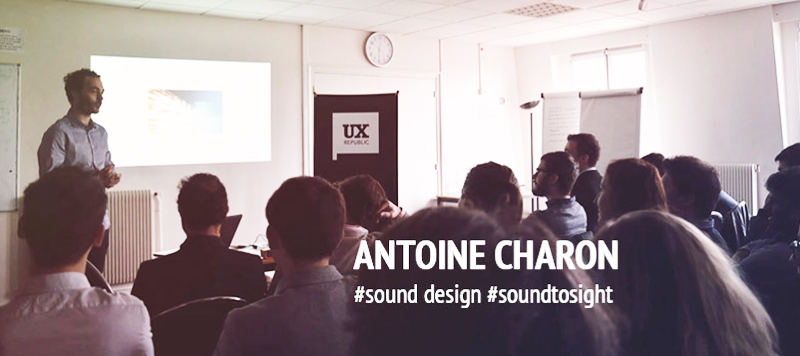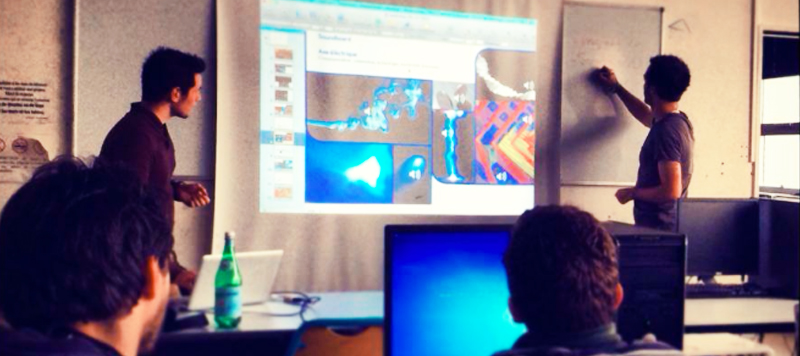Sound has meaning, sound gives meaning. Sound design is an added value in the service of marketing and brand management, consciously or not, we all have in mind “the clicking” of our smartphone when we write a text message or the sound of a car door slamming – behind this daily newspaper hide experts in Sound Design.
Let's discover together what thought is behind the creation of a sound design? What are the best practices ? How to create a link with the consumer? To answer all our questions, Antoine Châron sound designer of the agency Sound-to-sight will help us discover this new approach to design.
First of all, what is sound design?
The sound design is something sprawling. For us, it's giving meaning through sounds.
It is sound creation applied to all areas that may require the contribution of sounds. Of course we are thinking of cinema, radio, advertising; but sound design also affects architecture, connected objects, interfaces, scenography, automobiles, and the disabled. Sound design, unlike a purely musical practice, adapts traditional designer analysis methods to determine concepts and realize sounds which will be adapted to the use, to the behaviors, and a fortiori to the design and the brand image. The ultimate goal, linking ergonomics to aesthetics and marketing.
What are the methods of creation and reflection of a sound designer?
The problem with sound design is vocabulary. We live in a society that culturally and consciously uses its sense of vision more easily than others. So when we make sounds of a few milliseconds, we are naturally at a loss to tell our customers about it.
We have developed two tools that allow us to fill this gap. They allow on the one hand to put words on the impalpable, but in addition, to involve the development teams in the creative process.
First there is the "soundboard" which, like the traditional moodboard, connects words and images to define a universe, whether it is that of a product or a brand. Except that we add sounds, sounds from the collective imagination, from films, from nature, from various sound objects. Then all together we listen to them, validating some while deleting others. The few remaining validate a common idea of the sound universe towards which we will have to go for the creation. This phase of defining the sound universe is essential, she makes a first contact with the client, friendly contact and which involves her directly in the project. But above all, without this phase, we would be forced to express our own sensibilities in a context where the specifications are never defined; we would therefore go in a direction that would be our own interpretation of a particular word, for example "organic", "woody", "family", "sensual". By doing this, we would have a high probability of going in an inappropriate sound direction. Because the customer, although unable to define his desire, nevertheless has an overall idea that must be understood in order to propose something in his direction or against it.
Another point that is specific to us, we are also the only ones to do this in this context, it is the graphic representation of sounds. It is impossible to listen to non-musical, short, abstract sounds, and to be able to comment on them in order to modify them, analyze them.
We design the sounds!
It's a work of synesthesia that allows anyone to be able to speak what they hear, and make graphic changes that we translate back into audio. Once again, this is an essential step for the process to move forward quickly and with as much serenity as possible. We are in the abstract; making it concrete reassures, involves and offers a better success rate.
How do you approach the concept of sound design with your clients?
This is a complicated question because each case is different. Moreover, our activity has not become habitual at all; we must therefore be pedagogical. On a particular case like that of man-machine interfaces, we are talking about several things. In particular the ability of sounds to convey meaning more quickly than graphic elements. Next, the unconscious ability of sounds to create mental images, to stimulate the imagination. To this, we add that in the globality and the multitude of what the market offers in terms of services or products, the customer struggles to find real elements of differentiation. However, sensory design is underused.
Sensory design is working on the senses in a global way to offer a particular experience to the consumer.
We know full well, thanks in particular to brain imaging and experimental psychology, that the senses interact with each other and that sounds, such as smell or taste, can completely change the perception of a product or even create a " emotional distortion”.
We also observe a multitude of negligence in household appliances, for example, with “highly technological” washing machines that emit loud sounds to indicate the end of a cycle. Or even the fact that the sounds in cars are identical whether you are in a luxury sedan or a small city car. Nobody really notices it, but by doing blind tests, we know that sounds can completely change the perception of a product and convey something else, an identity, a precisely perceived quality, values.
This is what we sell to our customers, differentiation, a new experience. What they may perceive as a detail is in fact the cornerstone of a global sensory approach.
When we all have the same services on our wrists, in our cars, in our homes, in our phones; and that the embodiment of this service will be intangible, the sound will be a true signature.
Carine Renaud, UX-Evangelist @CarineWhatElse - UXLab Foundation @UX-Republic
STORYTELLING: THE ART OF CONVINCING # Paris
SMILE Paris
163 quay of Doctor Dervaux 92600 Asnières-sur-Seine
UX/UI ECO-DESIGN # Paris
SMILE Paris
163 quay of Doctor Dervaux 92600 Asnières-sur-Seine
DESIGN THINKING: CREATING INNOVATION # Belgium
UX-REPUBLIC Belgium
12 avenue de Broqueville - 1150 Woluwe-Saint-Pierre
MANAGING AND MEASURING UX # Paris
SMILE Paris
163 quay of Doctor Dervaux 92600 Asnières-sur-Seine
DESIGN SPRINT: INITIATION & FACILITATION # Paris
SMILE Paris
163 quay of Doctor Dervaux 92600 Asnières-sur-Seine
UX-DESIGN: THE FUNDAMENTALS # Belgium
UX-REPUBLIC Belgium
12 avenue de Broqueville - 1150 Woluwe-Saint-Pierre
GOOGLE ANALYTICS 4 #Paris
SMILE Paris
163 quay of Doctor Dervaux 92600 Asnières-sur-Seine
ACCESSIBLE UX/UI DESIGN # Belgium
UX-REPUBLIC Belgium
12 avenue de Broqueville - 1150 Woluwe-Saint-Pierre














